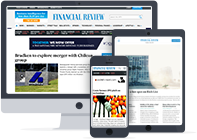
Half year profit results from Bendigo and Adelaide Bank contain some important pointers to industry-wide trends including the downward pressure on net interest margins and fee income, the need to slash staff numbers, and the uncertainty over credit quality in business.
Bendigo put in a better performance than expected in many areas of its business, most notably in its residential lending and in its HomeSafe business, which allows retirees to sell a share of the future sale proceeds of their homes.
Bendigo chief financial officer Richard Fennell said cost cutting was a critical part of the bank's ability to lift profits in the future and this would involve shedding more full time employees.
Bendigo cut its full time employees by 165 to 4424 in the year to December 2016 as part of an efficiency program that delivered the lowest cost to income ratio in two years. The bank's cost to income ratio is now 54.3 per cent.
Fennell says Bendigo is cutting costs with "a scalpel rather than a hatchet to the business".
One trend that will be impacting upon all banks is the reduction in fee income.
Fennell says fee income is down because of competition in new lending and the move by consumers to increasingly use the contactless technology payWave for point of sale transactions. That pushes up the interchange fees paid by Bendigo.
Bendigo chief executive Mike Hirst told banking analysts on Monday that the credit environment in Australia remained "benign" and he did not see any issues arising in the near term.
However, Bendigo's results were hit by more specific provisions from the Great Southern loan portfolio and deterioration in the bank's business loan portfolio.
Fennell said that a number of Great Southern loan clients are choosing bankruptcy.
Bendigo now has $100 million in Great Southern loans in dispute or 90 days in arrears.
On a positive note, Bendigo's total impaired assets were down 15 per cent and its provision coverage is now 100 per cent.
Another industry-wide trend identified by Fennell in his presentation is the continued use of large discounts for new home loans.
One of the surprises in the Bendigo result was the HomeSafe portfolio. Its $46 million contribution to profit was ahead of market estimates. This contribution is the result of a revaluation of the properties used for collateral.
But Hirst is concerned about the size of the HomeSafe business relative to the total Bendigo balance sheet. HomeSafe's total lending is now $360.9 million.
Another message for the industry to come from the Bendigo result is the importance of mobile banking technology. Hirst believes it is Bendigo's leadership in this area (second only to the Commonwealth Bank of Australia) which has given Bendigo the highest net promoter score among the regional and major banks.
The final, and for many investors the most lesson, from the Bendigo result is in relation to dividends. Bendigo has lifted its payout ratio significantly in order to keep its interim dividend at the same level as a year ago.
Boards of directors of all banks are conscious of this need to serve the interests of shareholders despite tough operating conditions.
